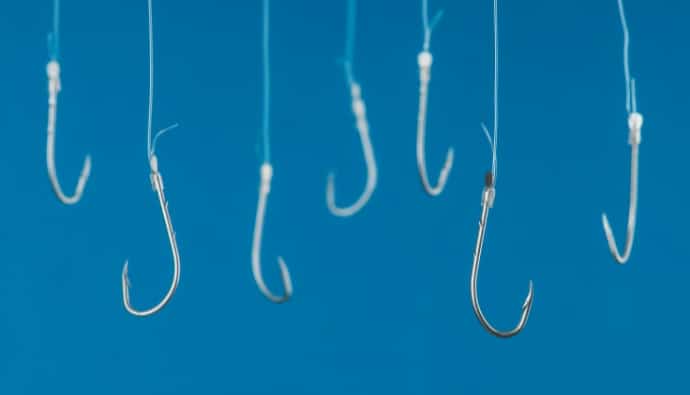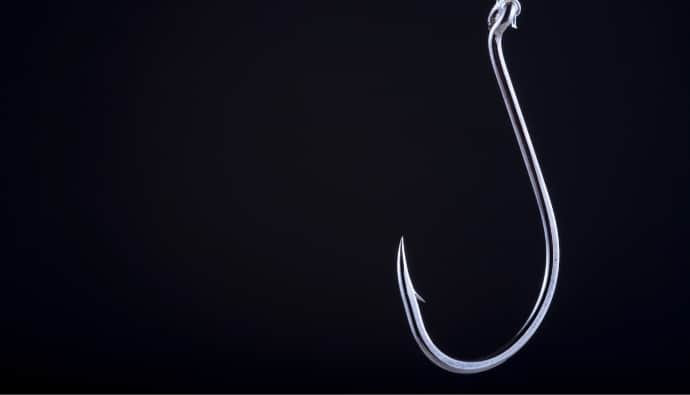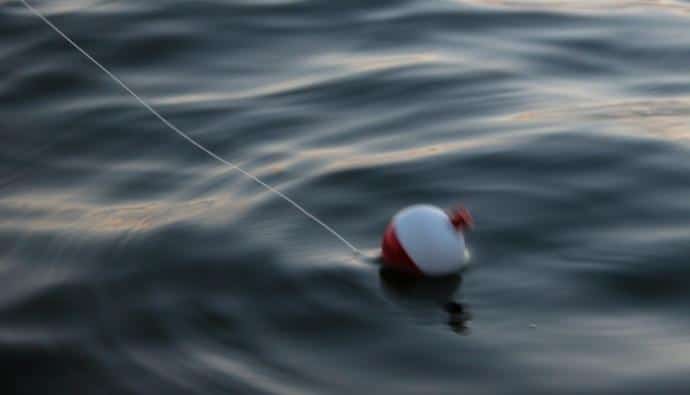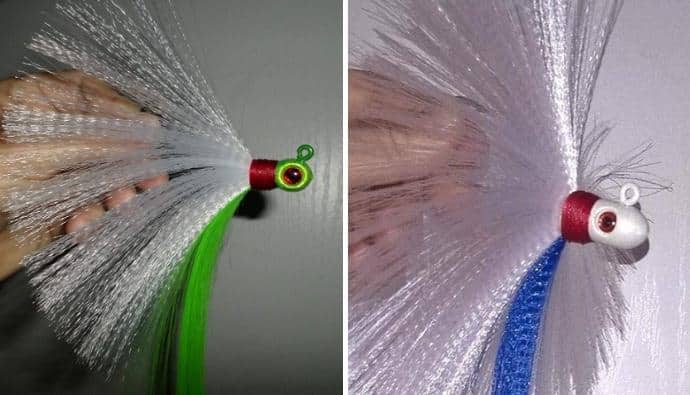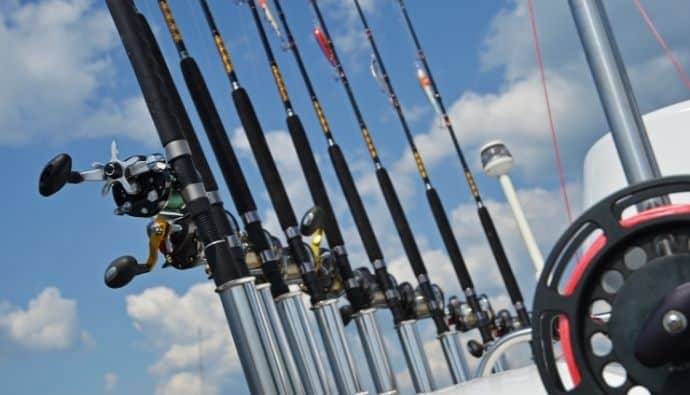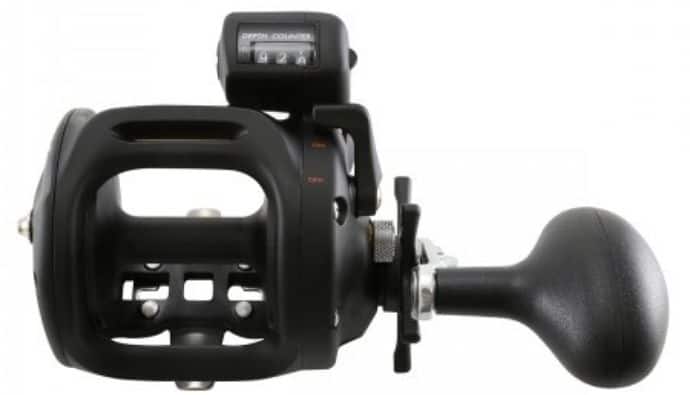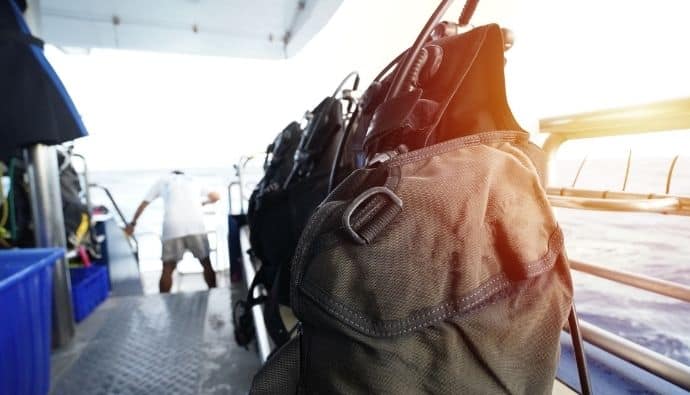The best fishing hooks are one the most important pieces of equipment you can have as a fisherman.
In 2005, the fish hook was chosen by Forbes as one of the top twenty tools in the history of man.
For this reason, it is essential to have the best fishing hooks in your tackle bag and on your rod and spinning reels.
A good selection of fishing hook types and sizes is vital to making your fishing trip more successful.
In this article, I will cover the best fish hook sizes, brands, and much more, including proper knots and fish-specific fishing hooks, to help you decide the best fishing hooks for your tackle box.
10 Best Fishing Hooks for 2023 Reviewed
- Best Circle Hook – Mustad UltraPoint Demon Wide Gap Circle Hook
- Best Octopus Hook – Gamakatsu Octopus Hook
- Best Treble Hook – Mustad Classic 4 Extra Strong Kingfish Treble Hook
- Best Light Circle Hook – Owner Mutu Light Circle Hook
- Best Baitholder Hooks – Gamakatsu 05413 Baitholder Hooks
- Sharpest and Best Engineered Hooks – Trokar Lancet Circle Non-Offset Fishing Hook
- Best Saltwater Big Game Hooks – VMC Corporation Inline Single Hook 1X Coastal Black
- Best Fly Tying Hooks – Umpqua Tiemco Fly Tying Hooks
- Daiichi 1130 Wide Gape Scud Hook
- Partridge Patriot Up-Eye Double
1. Mustad UltraPoint Demon Wide Gap Circle Hook
Best Circle Hook
These hooks are stellar! Billfish Foundation endorsed them for their design specs and meets the standards for catch and release style fishing.
These tough, sharp hooks have taken many trophy fish of different species.
These are some of the strongest hooks on the market, not to mention they are super sharp. These hooks stay sharp at least 20% longer than the nearest competitor.
Whether you’re going for billfish or panfish, these hooks will deliver. Give them a shot!
2. Gamakatsu Octopus Hook
Best Octopus Hook
We like these hooks because they’re not only effective at hooking fish but they are made in an environmentally friendly manner.
Taking care of the environment is important for us as fishermen, so we’re happy when fishing companies keep that in mind.
For the price, these hooks are durable, long-lasting, and can be changed out without concern. If you’re looking for one of the best hooks to go after that monster pike, then look no further, these have been tested and they work!
3. Mustad Classic 4 Extra Strong Kingfish Treble Hook
Best Treble Hook
This hook is the gold standard when it comes to treble hooks on the market today. It’s not uncommon for fishermen to get a lure and immediately replace the trebles on them with these.
That’s because it’s nearly impossible for a fish to headshake free from them.
They have a unique bend in the hook that forces the jaw into a spot that traps the hook against the jaw.
Couple that with patented Wire Technology that allows for a lighter yet stronger hook and you’re dangerous out there on the water.
We like their inline eyelet as well that allows the fisherman to set the hook with efficiency.
Whether you’re going for channel cats or stripers, these hooks will hold up just fine.
4. Owner Mutu Light Circle Hook
Best Light Circle Hook
We were turned on to Owner’s hooks a while back and we love them. Especially when it comes to these lighter-style circle hooks, it’s almost as if the fish hook themselves.
It doesn’t matter if you’re going for flounder, reds, or sharks, these hooks have been vetted by numerous fishermen over the years.
It’s not uncommon for them to just stick to Owner going forward for all their fishing challenges.
When in doubt, try a number five or six hook and get after everything from bluefish to sharks!
The Coach fully endorses this hook almost anywhere they would serve in an application, for any angler anywhere.
5. Gamakatsu 05413 Baitholder Hooks
Best Baitholder Hooks
A good set of baitholder hooks is important for every fisherman’s tacklebox. You want to make sure the hook can hold bait more securely to reduce the need to replace it.
These hooks are super sharp and durable and come with solid anchor points for locking your bait down securely.
If you’re using them in saltwater, rest assured that they are strong against corrosion.
6. Trokar Lancet Circle Non-Offset Fishing Hook
Sharpest and Best Engineered Hooks
These surgically-sharpened hooks give an extra side to the point which makes it much more efficient at penetrating a tough fish jaw than two-sided points.
This inline circle might be legal for use where an offset circle will not, as this is a regulatory condition in some areas for circle hooks.
These hooks aren’t as common out in the field, but that’s starting to change. If you’re having problems with your hookup ratio, then it could be because you need a hook that is sharper.
Those who’ve fished with the Tokar Lancet have said nothing but amazing things. Give them a shot!
7. VMC Corporation Inline Single Hook 1X Coastal Black
Best Saltwater Big Game Hooks
If you like to target big fish out in the water then you know how important it is to have hooks that are strong not only against the fish but to stand up to the corrosion.
These hooks are coated many times with VMC’s Coastal Black finish to help protect them from the elements.
If you’re not planning on keeping the fish then it’s important to swap out your treble hooks on your lures with a solid single hook option.
We recommend swapping them out with these hooks as it limits the damage to the fish while still giving you a good hookup ratio.
8. Umpqua Tiemco Fly Tying Hooks
Best Fly Tying Hooks
These are amazing if you’re going to be making saltwater flies by hand. They have a straight eye and have a super sharp point. They are 3X heavy, 3X wide, and 2x short, which makes for the perfect combination for your flies.
These are a bit pricey, but if you’re going to be making your own flies, you should use the best. It’s a must have for every fly tying kit.
9. Daiichi 1130 Wide Gape Scud Hook
This is a great hook if you’re going to tie your own flies. The Scud Hook became popular in the 80s and for good reason, the shape is the same curvature of the freshwater shrimp and gives your flies a more natural shape.
These hooks are great for tying scuds, pill bug patterns, estaz eggs, and more.
10. Partridge Patriot Up-Eye Double
This is a unique hook if you’re looking to do some of the newer salmon and steelhead patterns for your next outing. Some might even say they are the best salmon hooks on the market.
If you’re going to be tying your own flies, then you might as well do it on some high-quality and durable hooks. Don’t let the dream fish get away because you wanted to save a few pennies on hooks.
Fishing Hook Anatomy

Contemporary hooks come from either high-carbon steel, steel alloyed with vanadium, or stainless steel, depending on the application. Most quality fishing hooks have some form of a corrosion-resistant surface coating as covers.
Corrosion resistance helps not only when using fishing hooks, especially in saltwater, but also when storing. Additionally, coatings give color and/or provide aesthetic or penetrative value to the hook.
At a minimum, fishing hooks designed for freshwater use have a clear lacquer coating, but hooks may have gold, nickel, Teflon, tin, and different color coatings.
Commonly referred to parts of a fish hook are:
- The point, is the sharp end that penetrates the fish’s mouth or flesh.
- The barb, the projection extending backward from the point, secures the fish from unhooking.
- The eye, is the loop at the end of the hook that connects to the fishing line or lure.
- The bend and shank, that portion of the hook that connects the point and the eye.
- The gap, is the distance between the shank and the point. In many cases, the use of various parts of the hook describes the fishing hook itself, for example, wide gap, long shank, hollow point, or out-turned eye.
Common Hook Types
Literally, thousands of hook styles are available today, making the selection process confounding for even the experienced angler. The following hook types are the most commonly available today.
Regardless of the hook type, you should match the size of the hook to the bait you are going to use and the size of the species you’re targeting.
Baitholder Hooks
Keeping slippery, wiggling live bait on a hook is a challenge, and manufacturers have developed several designs to make it easier.
Generally, a baitholder fishing hook has long shafts, and they often have barbs on the shaft to assist in keeping bait securely hooked.
A baitholder fishing hook is also commonly available as snells, pre-tied to the line that loops at the end and attaches readily with a knot, swivel, or snap.
When fishing for walleye in the spring, using a live-bait presentation, snells with sizes four to eight are common, while bass fishermen use 1/0 to 2/0 hooks for shiners or minnows (a whole bucket of minnows).
Worm Hooks
This particular hook is for worms of the plastic persuasion, and a mainstay for bass fishermen. Since bass are heavy fighters, worm hooks are sturdy for deep penetration and durability.
This type of hook is often used for Texas rigging, a technique in which the point of the hook embeds in the body of the worm for a weedless presentation.
With the hook’s point buried in the body of the worm, you can work it through heavy cover where lunkers like to hide.
A worm fishing hook usually has a wide gap, where the space from the point of the hook to the shank is wider than standard hooks.
The advantage of using wide-gap hooks is that worms of different sizes can be used and the hook can be embedded easily in a natural configuration.
Common sizes for worm hooks are 2/0 to 5/0 and should match the size of the plastic bait to be used and the size of the bass you expect to catch.
Keep in mind that very large bass have been landed on very small pieces of plastic.
Double Hooks
This hook design is similar to a treble but with only two points. Double hooks are great for use in a trailer-hook setup or for thick-bodied soft plastic baits like floating frogs.
They are also commonly used on trolling lures, as they tend to be stable at higher speeds, resisting spin.
This will usually ensure a top lip hook and makes it more difficult for the fish to spit out the lure without being hooked.
Treble hooks
The three legs of a treble hook forge together to form the eye. Multiple J hook points provide superior hooking and holding power for lures such as crankbaits or bucktail jigs for muskellunge or pike.
Crankbaits for bass or walleye usually employ treble hooks size 1 to 2/0, but sizes vary with the size of the lure.
These hooks snag easily and tear a fish’s mouth, making them a bad choice for catch and release, or areas of heavy cover. In some areas, treble hooks are illegal to use.
J Hooks
J hooks work better when a fish takes a bait slowly, doesn’t move off after the strike, or continues moving directly forward after a strike.
Striped bass taking bunker chunks, and most panfish eating most baits, provide examples.
Since these fish don’t usually move off immediately after eating, you’ll be pulling the hook in a straight line with the fish’s body.
Because they’re shaped like the letter “J”, J-hooks are the oldest hook shape used by recreational anglers and are still by far the best hook to use if you are trolling live bait behind a moving boat.
It’s always mentioned in alligator gar fishing tips.
The shape of the hook and the fact that the barb doesn’t point inward dramatically, improves the percentage of hits you get that will end up actually setting the hook and catching a fish.
The downside of the J-hook is when they don’t match the size of the fish, they tend to lodge themselves deeply or get swallowed, usually resulting in death. J- hooks are either non-offset or offset.
A circle hook will slide right out of its mouth, but a J hook will (hopefully) snag something on its way out.
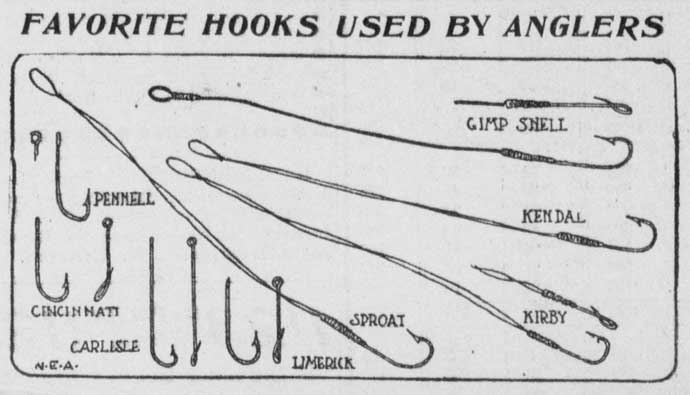
Circle Hooks
This design is for the hook point to roll into the corner of the fish’s mouth after he takes the bait. You do not “set” this type of hook.
With the circle hook, you simply reel in when you feel the fish on the other end — never jerk or set the hook! These hooks are to rotate in the fish’s mouth and settle in the corner of the jaw.
This design lowers fish mortality and is a requirement in some states when fishing for certain species, such as reef-dwelling fish.
Circle hooks are also either non-offset or offset. Non-offset circle hooks have the point aligning evenly to the shank, conversely, the offset hooks align at an angle to the shank.
Often, regulations may specify inline, non-offset circle hooks, be sure to check your local laws.
When fishing live or dead bait for large species such as catfish, pike, or muskie, a circle hook is a good choice.
Here’s how this configuration works:
- Fish often swallow the bait and hook, especially if you take your eyes off the rod tip for more than a few seconds.
- When you get a bite using a circle hook, you gently lift the rod tip and begin reeling in line. This allows the hook to slide backward until it penetrates at the angle where the jaw rises up to form the lip.
Octopus Hooks
Short shanked-octopus hooks feature a round shank and bend, but it’s not as dramatic as circle hooks.
Octopus hooks are often used for bait fishing when minimal hook weight and size is essential for a natural presentation. These hooks are great for hooking a leech through the sucker.
The Bass Pro Shops XPS Octopus hook is a good example and is highly rated. A mosquito hook is a variation of this style.
The Octopus hook is ideal for rigging cut bait for catfish or salmon, minnows for bass, pike, and walleyes, and is a good choice for building crawler harnesses.
Octopus hooks are available in an assortment of painted or metallic colors.
Weedless Hooks
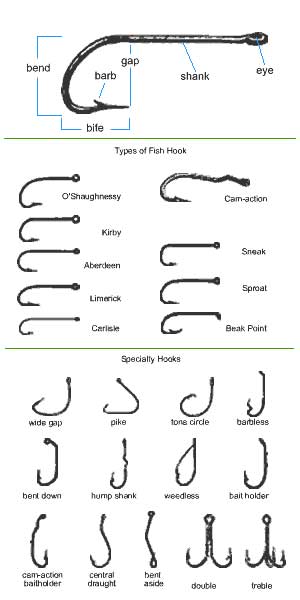
When fishing heavy covers such as tree limbs, logs, stumps, weeds, and rocks, a weedless hook can save you a lot of time, money, and frustration.
You’ll find several different approaches to making a hook weedless, and they all work fairly well, but remember, they’re weed-less, not 100% weed proof. You’ll still have to work your bait or lure carefully.
The weedless hook has a light wire wrapped on the shank formed in a loop that covers the point of the hook.
This allows fishing the hook in weeds, logs, trees, stumps, rocks, and lily pads. Upon a fish striking the bait the wire compresses exposing the hook point.
Aberdeen Hooks
Aberdeen hooks have a lighter wire than Siwash hooks and are usually used for bait fishing. The thin metal easily hooks bait with minimal damage so it stays lively.
The (typically) longer shank on these hooks makes removal from the mouth of panfish or other soft-mouthed fish much more simple.
The light wire also makes them a good option when fishing timber for crappie. When snagged, you can sometimes bend the hook and pull it free with a bit of pressure.
Aberdeen hooks are also a good choice for catch and release, as they do minimal damage to a fish’s mouth.
Siwash Hooks
Long-shanked Siwash fishing hooks have a straight eye to ensure they sit properly on lures.
Siwash hooks are often for single-hook baits, such as spinnerbaits. They’re also an excellent alternative to factory-provided treble hooks on spoons and other baits.
These hooks are handy to replace treble hooks on hard baits when fishing a zone that limits hook points on a per lure. The Gamakatsu Siwash Open Eye hook is a quality Siwash hook.
Jig Hooks
Jigs are simply hooks with lead or other heavy metals, forming various shapes for special applications.
Jigs are for both live baits such as minnows or crawlers in walleye presentations, or for soft plastics when fishing for crappie or bass, and other species.
When using plastic baits such as twister tails, crawdads, or worms, select a jig with a molded collar or barb just behind the jighead.
This collar provides a good hold of plastic baits more securely, so make sure you force the bait onto the collar.
King Kahle Hooks
The King Kahle hooks are large hooks that accommodate live bait or cut pieces of fish (cut bait)
King Kahle hooks have a unique bend that prevents live bait from coming off the hook while keeping the hook point exposed.
These hooks need to be set like J hooks. King Kahle hooks are best used for catfish, because of their strength and design.
Shiner Hooks
These hooks are a smaller version of the Super Kahle hooks. They are primarily for fishing largemouth bass using live minnows and shiners.
The hook size should be based on the size of the shiner you fishing with. On average the 5/0 Kahle hook is the starting point.
Kahle hooks have a wider gap between the eye and hook points than circle hooks.
When you go to purchase your hooks, some companies will just label them shiner hooks, while others just label them Kahle hooks. They are both the same.
Punch Bait Hooks or Stink Bait Hooks
The punch bait hooks tend to use treble hooks, with a unique device that holds soft, gooey baits, such as catfish baits.
Stink bait hooks are for catfish anglers, due to their easy-to-rig punch bait design that allows the angler to simply push the hook down into a catfish bait bucket and pull it out by the line and the hooks ability to hold the bait without it slinging off while casting.
Punch bait hooks come in a variety of catfish hook sizes, making them very popular with catfish anglers.
Swimbait Hooks
These hooks can keep your swimbaits upright in the water and on the hook. Swimbait hooks often have lead in the shank or a screw near the eye.
This weight helps your bait drop more naturally instead of just dropping nose down.
Swimbait hooks need to be set the same way as J hooks.
Hook Sizes
Choosing the correct hook size is always a compromise.
Smaller hooks are hard for fish to detect, easier to swallow (causing gut hooking), be pulled out of the mouth easier, and break easier.
However, smaller hooks are easier to set, are affected less by current, can cast farther, and you can catch small or large fish.
It is advisable to pick a hook that will easily pop into a fish’s mouth, specific to the species you are fishing for.

When it comes to hook size, you have to think backward.
- The smallest hook sizes have the largest numbers such as 25, 30, 32, etc., and the largest hooks have designation: with a 0, or progressive sizes of 0 such as 18/0, 19/0, and 20/0.
- Larger hook sizes refer to as 20/naught and so on.
- Currently, 20/0 hooks are the largest, and size 32 is the smallest.
Hooks classification is by “sizes” — for example, a size 1 hook is larger than a size 7, while a 1/0 is smaller than a 7/0 (pronounced 7-aught). The smallest standard sizes available are 32 and the largest 20/0.
The slash symbol ( / ) defines a hook as grouped within the “aught” measurement system. As defined in the aughts, the higher the number, the larger the hook.
A 1/0 hook is bigger than a size 1. They ascend in accordance to their increased size. For this reason, a 6/0 hook is larger than a 2/0, but a plain 6 is smaller than a 2.
Hooks are also from various wire gauges or thickness. They run from very thin wire to thicker gauge wire, for example, fine wire, heavy wire, extra heavy, 2X heavy, 3X heavy, 4X heavy, and higher.
It is important to remember, each manufacturer has their own hook size, they are not the same across all brands or fishing hook types.
Fishing hooks are also different sizes between styles, as well as brands. For example; A 4/0 shiner hook is VERY different from a 4/0 circle hook.
How to Set a Hook
A good rule of thumb when learning how to fish is to wait and feel the weight of the fish before setting it.
If the fish is cautious and just tapping your fishing line and bait lightly, and not biting it, it’s best to wait. Let the fish take the bait, and then set the hook after you feel its weight.
For the best results, be sure to use the proper fishing hook setup.
For example, the use of circle baits when fishing catfish often eliminates the need to set the hook, as it generally gets caught in the fish’s mouth automatically, but also requires an angler to reel into the fish instead of setting the hook.
To help you better know how to set the hook, look for common signs a fish is biting such as your bobber is pulled completely underwater, you feel a true tug on your fishing line or your fishing line starts moving.
Reel in the slack and keep your line tight with the bait or lure. This helps increase the sensitivity allowing you to feel the fish bite and be in a better position to set the hook.
You want to make sure as you set the hook, you use enough pressure to get the barb to penetrate the fish’s mouth.
The motion of setting the hook is relatively simple. But it can sometimes be difficult to tell if you have a bite or if you’re just feeling the current or a fish bumping into the bait.
The more you know about the fish species you’re after, and the more time you spend on the water practicing, the better you’ll get.
Fish with hard mouths such as tarpon and bass need a hard hook set, while fish with soft mouths such as carp, crappie, or trout do not need a hard hook set.
(If you set the hook too hard, it can tear out of the fish’s mouth)
What to Look for in Quality Hooks
Quality and dull resistant pointed tip: this can eliminate the need for frequent sharpening.
Strong yet flexible: to allow the hook to give enough to prevent breaking or tearing out of the fish’s mouth.
Price: Prices can range from $1.00 per dozen to $1.00 each. When it comes to quality, you often get what you pay for.
Hook Care
The biggest enemies to your fishing hooks are rust and wear especially while saltwater fishing. This can especially be true for saltwater fishing hooks.
A jewelers loupe eye or a good magnifying glass can allow you to see early signs of wear, corrosion, or small fractures, that can tell you when it is time to retire your fishing hook.
A sharpening stone or a piece of sandpaper can be used to sharpen the point of hooks that are showing signs of dulling.
A fish hook holder can help protect your hooks for a longer lifespan, also the separate compartments make retrieving the correct hook easy.
Tips for Using Hooks
When fishing with live bait, you should consider which hook to use and how live bait should be hooked to ensure the most natural presentation and to keep the bait alive longer.
How to safely remove the hook from your catch (also called “de-hooking”):
- Be careful and quick, twist the hook while pushing it toward the bend.
- Use fishing pliers or a dehooking tool if the hook is deep in the mouth or has teeth.
- Remove treble hooks one at a time to release all three.
- If the fish swallows the hook, cut the line inside of the mouth and release the fish without removing the hook if you aren’t retaining the fish.
Baiting a Hook
Most anglers have their own method for baiting their hooks. A good rule of thumb is to hold the hook with the fingers of your left dominant hand and use the fingers of your opposing hand to attach the bait to your hook.
The goal with most rigs is to make them look as natural as possible. Depending on the species of fish you are going after, the baits can vary greatly.
With punch baits, for catfish, that only requires you to stick the hook into the bait and pull it out.
Called a bait holder hook, this is a relatively simple bait to use, where Texas and Carolina rigs, for bass, can be more complex.
Troubleshooting Your Hooks
If you are getting several bites but can not get the hook set, you are probably using too big of a hook.
Smaller fish are biting your hook and are not able to set. Keep progressively shrinking your hook size, bait and lure until you catch what is biting.
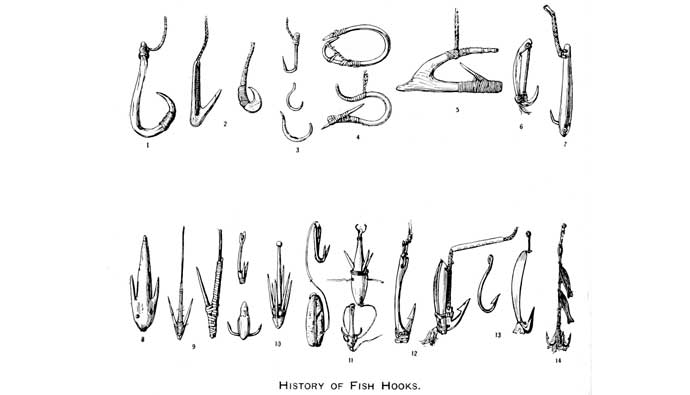
If you are hooking a fish and fighting, if the hook releases when you pull hard, that means the hook is pulling out.
This can simply be bad luck, due to where the fish was hooked in the mouth, but if it happens often it could be using too high of a drag setting and fighting the fish too aggressively.
It could also be that you are using too small of a hook, which has too small of a hook gap. Thin hook gauges increase the chance of the hook tearing or pulling out.
If fish are spitting out your hook, you are not hook-setting well enough. Try a sharper hook, and work to improve your hook setting technique.
Frequently Asked Questions
Most bass fishermen use sizes 1 to 2/0 for minnows and shiners. Walleye fishermen will get bait hooks as snells pre-tied with line and smaller four to eight size hooks.
These hooks come as small as size 14 and as large as 6/0. An Aberdeen Hook is another hook that is used for live bait, particularly worms and leeches.
When bait fishing for rainbow trout in lakes, for example, single hooks size 4 to 12 will work with weights, small split shots to sliding weights that are up to a ¼ oz.
Hook size should ALWAYS be matching the size of your bait whenever possible. Eagle Claw offers a wide variety of hooks if you are on a budget.
Refer above to the graphic showing the various styles, sizes, and colors Eagle Claw has to offer. Typically, circle hooks offer an easier hook set, basically the fish hooks itself. This is a good choice for fish that have softer mouths.
For sport fish that have tougher mouths, J hooks would be a better choice. J Hooks have shown to be the best hooks for bass fishing. Just remember, you have to set these hooks when the fish strikes.
The act of setting a hook into or around the jaw of a fish.
Larger hook (5/0-8/0) Are the best hooks for redfish, but you can base your hook size on the size bait you will be using.
Trolling gear for redfish should consist of at least medium-weight rods and a reel spooled with at least 250 yd of tough line.
A circle hook is a type of fish hook which is sharply curved back in a circular shape. It has become widely used among anglers in recent years because the hook generally catches more fish and is rarely swallowed.
Treble hooks consist of three hooks with a single eye. These hooks are used by anglers in a variety of applications and on many fishing lures.
Note; Some areas have banned the use of treble hooks. It is advisable to make sure these hooks are legal in your area.
Sizes 5/0 to 8/0 used with live eels, cut bait, and clams for striped bass.
The Texas rig can be used in a variety of ways. Texas-rigged lures are typical 3/0 straight shank for plastic lizards, Senkos and 6-inch plastic worms;
4/0 straight shank for 7- to 8-inch plastic worms;
5/0 straight shank for 10-inch or longer plastic worms; 4/0 extra-wide gap (EWG) for beaver baits and craws;
5/0 EWG for creature baits and flipping tubes.
Octopus hooks are short-shank hooks that feature a round shank and bend, but it’s not as dramatic as circle hooks.
Octopus hooks are often used for bait fishing when minimal hook weight and size is essential for a natural presentation.
Typically size #1 and #2 work best but sizes range from 2/0 down to #6. Weights range from 1/8 up to 1/2 ounce, but the best selling weights are 3/16 and 1/4 ounce.
Note: Line is also a special consideration. This is a light line technique and 4-10 pound test is usually the range with most anglers using 6-8 pound.
For the largemouth and smallmouth bass fishing, sizes are 6/0, 5/0, 4/0, 3/0, 1/0, 1, 2, and 4 are the best fishing hook sizes.
Definitely, the size depends on the technique one uses. Sometimes, fish hooks that are larger or smaller than this range are utilized.
Some use standard hooks, others use the traditional salmon or steelhead hook, which is a thicker, short shank, eye-up hook. Hooks used are larger than normal, with hook sizes of at least size 2 or larger commonplace.
The Mustad demon perfect circle hook (size 3/0) is the best circle hook for redfish. For larger sizes, refer to their circle hook size chart.
Octopus hooks are often used for bait fishing when minimal hook weight and size is essential for a natural presentation. These hooks are great for hooking a leech through the sucker.
Siwash hooks are excellent replacement hooks for spoons, spinners, or plugs. They have an open eye, a unique tempering process and high-carbon steel construction ensure superior strength and durability.
The sticky sharpness is the result of a patented mechanical needle-honing process developed to ensure you get the sharpest hooks possible.
Circle hooks are recommended for trout fishing-both because they are good for the fish (less swallowed hooks, easier to get the hook out) and because the toughest part of the trout’s mouth is near the corner.
Trout have notoriously soft mouths, and many times the hook simply pulls free after gouging a large hole in the fish’s mouth.
Hooks should be scaled to match the bait, allowing it to swim freely without weighing it down too much. Light-wire hooks are a good choice when fishing for trout.
For smallmouth and largemouth bass fishing the most appropriate sizes will be sizes 4, 2, 1, 1/0, 2/0, 3/0, 4/0, 5/0 and 6/0.
Of course, the size varies depending on the technique you’re using and fish hooks that are smaller or larger than this range are sometimes used. Always match the hook size to the bait you intend to use.
Treble hooks in the appropriate size range for channel catfish are size #2, #4, #6 and #8. The smaller the number, the larger the hook is so a #2 hook is much larger than a #8 hook.
The #6 size is a good all-around size hook when fishing for numbers channel catfish with prepared bait.
Note: Some areas have banned the use of treble hooks. It is advisable to make sure these hooks are legal in your area.
Contemporary hooks are manufactured from either high-carbon steel, steel alloyed with vanadium, or stainless steel, depending on the application.
Most quality fish hooks are covered with some form of the corrosion-resistant surface coating. Carbon steel is good if you want your hook to rust out of a fish while saltwater fishing.
Fish hook size depends greatly on the species of fish you are going after, and the bait you will be using. It is wise to have a good selection of sizes and styles of fish hooks in your tackle bag.
Worms are the most commonly known fishing baits, so the following is an example:
This bait is widely used in many types of fishing. Use earthworms or manure worms in freshwater and bloodworms or sandworms in saltwater. Mealworms and other live grubs are usually used for trout or panfish.
Pierce through several smaller worms or cut up worm halves to hide the hook in a mass of wriggling worms. Some hooks come with smaller hooks attached to the side for this purpose.
For large worms, thread a single worm along the hook until the hook is mostly or completely hidden. For very large worms, pierce the hook through several points of the body.
Leave a length at the end to wriggle and attract fish.
If you are dragging the bait behind you in a moving boat (trolling), hook the fish under its jaw and exit through the top, or just through its upper jaw for especially large bait fish.
Alternatively, you can hook it through both nostrils. Any of these hook methods will maximize the fish’s ability to swim with a natural motion to attract predator fish.
For fishing while still or moving slowly, hook the baitfish on its back just in front of the dorsal fin. Hook it underneath the spine to avoid paralyzing it.
This forces the fish to swim more frantically and head-downwards, attracting attention. You can fine-tune the depth by placing it further ahead of the dorsal fin; this causes it to swim at a shallower downward angle.
If you are free lining (fishing while stationary, using no floats or weights), you can hook the bait near the tail to make it swim forward. To force it to swim downward instead, hook into the mouth and exit through the gills.
In order to “set” a fish hook into the mouth of a fish once it has bitten a fishing lure or bait. In order to secure the fish on the hook, a sharp motion is performed to push the barb of the hook into the fish’s mouth, preferably in the corner.
If this motion is not performed, while it is possible for a fish to set itself, the likelihood of successfully landing the fish is minimal since, without the barb of the hook secured, the fish could shake the hook out of its mouth.
The motion is usually a sharp, sweeping motion of the rod, either upwards or to the side, depending on the orientation of the rod at the moment the fish bites.
Some fishermen will perform several hooksets in quick succession to ensure that the fish is securely hooked, especially on fish with tough mouths such as some saltwater species.
In contrast, anglers using circle hooks needn’t set the hook, since the hook’s design allows it to set itself when the angler reels in.
One of the easiest ways to make a hook weedless, is to attach your lure, let’s say an artificial worm, starting with the head, push the hook through the body, lengthwise, approximately 1 inch.
Let the point exit the lure, push the head all the way up to the eye. Bring the body around to the point and push the point though, just until the point starts to protrude.
Straighten your worm to a natural look without allowing the point to pierce all the way through.
Insider Advice
Whether you are going out for a Saturday afternoon fishing trip with the family, or a professional angler, you have plenty of options when it comes to fishing hooks.
Knowing which hooks to use for which species of fish, as well as the way to set the different types of hooks, is crucial to the success of your fishing trip.
Out of the fishing hooks covered in this article, Gamakatsu hits the number one spot.
For durability as well as reliability, Gamakatsu has superior hooks as well as versatility.
Fish hooks are one of the oldest tools ever invented and are still widely in use today. Not much different today than when it was first invented, the fishing hook then, as well as now, has been a necessity that quite literally, no angler can live without.
DISCLAIMER: Always check your local fishing regulations for which hooks are allowed in your area.




 Facebook
Facebook YouTube
YouTube